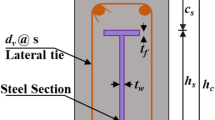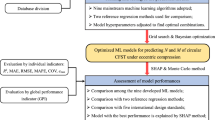Abstract
Currently, ferrocement members are being increasingly used in civil engineering projects. However, the literature still lacks investigations on the potential of using machine learning techniques in predicting the properties and behavior of such members. This study fills the gap in the literature by providing a detailed study that investigates the application of ensemble machine learning approaches in estimating and parametrically assessing the moment capacity of ferrocement members. Additionally, a notable contribution of this study is integrating feature importance and partial dependence analysis. These analytical methods allow for a detailed parametric assessment, aiming to understand the influence of each parameter on the moment capacity. As part of the study, several key input parameters are considered through utilizing a comprehensive database derived from tests on ferrocement. These parameters include the width and depth of specimens, cube compressive strength of mortar, and wire mesh’s tensile strength and volume fraction. The ensemble machine learning approach offers potential advantages in terms of accuracy and reliability over traditional methods. This research underscores the importance of advanced predictive tools in civil engineering and their potential to enhance the understanding and prediction of moment capacity in ferrocement members. The findings from this study can serve as a foundation for future research, aiming to further refine and optimize the prediction models for various construction materials and methods.










Similar content being viewed by others
Data availability
Some or all data, models, or codes that support the findings of this study are available from the corresponding author upon reasonable request.
References
Amin, M. N., Khan, K., Javed, M. F., Aslam, F., Qadir, M. G., & Faraz, M. I. (2022). Prediction of mechanical properties of Fly-Ash/Slag-based geopolymer concrete using ensemble and non-ensemble machine-learning techniques. Materials, 15(10), 3478.
Chen, T., & Guestrin, C. (2016). XGBoost: a scalable tree boosting system. In Proceedings of the 22nd ACM SIGKDD International Conference on Knowledge Discovery and Data Mining (pp. 785–794).
Dabiri, H., Farhangi, V., Moradi, M. J., Zadehmohamad, M., & Karakouzian, M. (2022). Applications of decision tree and random forest as tree-based machine learning techniques for analyzing the ultimate strain of spliced and non-spliced reinforcement bars. Applied Sciences, 12(10), 4851.
de-Prado-Gil, J., Palencia, C., Silva-Monteiro, N., & Martínez-García, R. (2022). To predict the compressive strength of self compacting concrete with recycled aggregates utilizing ensemble machine learning models. Case Studies in Construction Materials, 16, e01046.
Erdem, H. (2015). Predicting the moment capacity of RC beams exposed to fire using ANNs. Construction and Building Materials, 101, 30–38.
Eskandari, H., & Madadi, A. (2015). Investigation of ferrocement channels using experimental and finite element analysis. Engineering Science and Technology, an International Journal, 18(4), 769–775.
Friedman, J. H. (2001). Greedy function approximation: a gradient boosting machine. The Annals of Statistics, 29(5), 1189–1232.
Gandomi, A. H., Roke, D. A., & Sett, K. (2013). Genetic programming for moment capacity modeling of ferrocement members. Engineering Structures, 57, 169–176.
Ghanizadeh, A. R., Amlashi, A. T., & Dessouky, S. (2023). A novel hybrid adaptive boosting approach for evaluating properties of sustainable materials: a case of concrete containing waste foundry sand. Journal of Building Engineering, 72, 106595.
Ghunimat, D., Alzoubi, A. E., Alzboon, A., & Hanandeh, S. (2023). Prediction of concrete compressive strength with GGBFS and fly ash using multilayer perceptron algorithm, random forest regression and k-nearest neighbor regression. Asian Journal of Civil Engineering, 24(1), 169–177.
Habib, A., & Yildirim, U. (2022). Estimating mechanical and dynamic properties of rubberized concrete using machine learning techniques: a comprehensive study. Engineering Computations, 39(8), 3129–3178.
Habib, A., Yildirim, U., & Habib, M. (2023a). Applying kernel principal component analysis for enhanced multivariable regression modeling of rubberized concrete properties. Arabian Journal for Science and Engineering, 48(4), 5383–5396.
Habib, M., Bashir, B., Alsalman, A., & Bachir, H. (2023b). Evaluating the accuracy and effectiveness of machine learning methods for rapidly determining the safety factor of road embankments. Multidiscipline Modeling in Materials and Structures, 19(5), 966–983.
Ibrahim, H. M. (2011). Shear capacity of ferrocement plates in flexure. Engineering Structures, 33(5), 1680–1686.
Ismail, A. (2019). Estimating moment capacity of ferrocement members using self-evolving network. Frontiers of Structural and Civil Engineering, 13, 926–936.
Kaish, A. B. M. A., Jamil, M., Raman, S. N., Zain, M. F. M., & Nahar, L. (2018). Ferrocement composites for strengthening of concrete columns: a review. Construction and Building Materials, 160, 326–340.
Kalman Sipos, T., & Parsa, P. (2020). Empirical formulation of ferrocement members moment capacity using artificial neural networks. Journal of Soft Computing in Civil Engineering, 4(1), 111–126.
Kaveh, A., Dadras, E. A., Javadi, S. M., & Geran, M. N. (2021). Machine learning regression approaches for predicting the ultimate buckling load of variable-stiffness composite cylinders. Acta Mechanica, 232, 921–931.
Kaveh, A., Elmieh, R., & Servati, H. (2001). Prediction of moment-rotation characteristic for semi-rigid connections using BP neural networks. Asian Journal of Civil Engineering, 2(2), 131–142.
Kaveh, A., Eskandari, A., & Movasat, M. (2023). Buckling resistance prediction of high-strength steel columns using metaheuristic-trained artificial neural networks. Structures, 56, 104853.
Khan, K., Ahmad, W., Amin, M. N., Aslam, F., Ahmad, A., & Al-Faiad, M. A. (2022). Comparison of prediction models based on machine learning for the compressive strength estimation of recycled aggregate concrete. Materials, 15(10), 3430.
Li, H., Lin, J., Lei, X., & Wei, T. (2022a). Compressive strength prediction of basalt fiber reinforced concrete via random forest algorithm. Materials Today Communications, 30, 103117.
Li, Z., Yoon, J., Zhang, R., Rajabipour, F., Srubar, W. V., III., Dabo, I., & Radlińska, A. (2022). Machine learning in concrete science: applications, challenges, and best practices. NPJ Computational Materials, 8(1), 127.
Ma, L., Zhou, C., Lee, D., & Zhang, J. (2022). Prediction of axial compressive capacity of CFRP-confined concrete-filled steel tubular short columns based on XGBoost algorithm. Engineering Structures, 260, 114239.
Mashrei, M. A., Abdulrazzaq, N., Abdalla, T. Y., & Rahman, M. S. (2010). Neural networks model and adaptive neuro-fuzzy inference system for predicting the moment capacity of ferrocement members. Engineering Structures, 32(6), 1723–1734.
Minde, P., Bhagat, D., Patil, M., & Kulkarni, M. (2023). A state-of-the-art review of ferrocement as a sustainable construction material in the Indian context. Materials Today: Proceedings.
Moein, M. M., Saradar, A., Rahmati, K., Mousavinejad, S. H. G., Bristow, J., Aramali, V., & Karakouzian, M. (2023). Predictive models for concrete properties using machine learning and deep learning approaches: a review. Journal of Building Engineering, 63, 105444.
Naaman, A. E., & Hammoud, H. (1992). Ferrocement prefabricated housing: the next generation. Journal of Ferrocement, 22(1), 35–47.
Naderpour, H., Eidgahee, D. R., Fakharian, P., Rafiean, A. H., & Kalantari, S. M. (2020). A new proposed approach for moment capacity estimation of ferrocement members using Group method of data handling. Engineering Science and Technology, an International Journal, 23(2), 382–391.
Naderpour, H., & Mirrashid, M. (2020). Moment capacity estimation of spirally reinforced concrete columns using ANFIS. Complex & Intelligent Systems, 6, 97–107.
Quek, S. T., & On, S. H. (1991). Uncertainty in flexural capacity prediction of ferrocement elements. Journal of Materials in Civil Engineering, 3(4), 263–277.
Rofooei, F. R., Kaveh, A., & Masteri, F. F. (2011). Estimating the vulnerability of concrete moment resisting frame structures using artificial neural networks. International Journal of Operational Research, 1(3), 433–448.
Saha, S., Mohanty, T., & Saha, P. (2023). An experimental study on behaviour of ferrocement. Materials Today: Proceedings.
Sakthivel, P. B., & Jagannathan, A. (2011). Ferrocement construction technology and its applications–A Review.
Salami, B. A., Iqbal, M., Abdulraheem, A., Jalal, F. E., Alimi, W., Jamal, A., & Bardhan, A. (2022). Estimating compressive strength of lightweight foamed concrete using neural, genetic and ensemble machine learning approaches. Cement and Concrete Composites, 133, 104721.
Singh, G., & Xiong, G. J. (1992). Ultimate moment capacity of ferrocement reinforced with weldmesh. Cement and Concrete Composites, 14(4), 257–267.
Tawab, A. A., Fahmy, E. H., & Shaheen, Y. B. (2012). Use of permanent ferrocement forms for concrete beam construction. Materials and Structures, 45, 1319–1329.
Ullah, H. S., Khushnood, R. A., Farooq, F., Ahmad, J., Vatin, N. I., & Ewais, D. Y. Z. (2022). Prediction of compressive strength of sustainable foam concrete using individual and ensemble machine learning approaches. Materials, 15(9), 3166.
Yan, H., He, Z., Gao, C., Xie, M., Sheng, H., & Chen, H. (2022). Investment estimation of prefabricated concrete buildings based on XGBoost machine learning algorithm. Advanced Engineering Informatics, 54, 101789.
Yasin, B., Maraqa, F., Al-Sahawneh, E., Al Adwan, J., & Alzubi, Y. (2022). A comparative assessment of regularized regression techniques for modeling the mechanical properties of rubberized concrete. The Open Civil Engineering Journal. https://doi.org/10.2174/18741495-v16-e2208170
Author information
Authors and Affiliations
Contributions
The authors confirm their contribution to the paper as follows: study conception and design: J.AA., J. AT, and Y. A.; data collection: J.AA. and J. AT; analysis and interpretation of results: J.AA., J. AT, and Y. A.; manuscript preparation: J.AA., J. AT, and Y. A. All authors reviewed the results and approved the final version of the manuscript.
Corresponding author
Ethics declarations
Competing interests
The authors declare no competing interests.
Additional information
Publisher's Note
Springer Nature remains neutral with regard to jurisdictional claims in published maps and institutional affiliations.
Supplementary Information
Below is the link to the electronic supplementary material.
Rights and permissions
Springer Nature or its licensor (e.g. a society or other partner) holds exclusive rights to this article under a publishing agreement with the author(s) or other rightsholder(s); author self-archiving of the accepted manuscript version of this article is solely governed by the terms of such publishing agreement and applicable law.
About this article
Cite this article
Al Adwan, J., Al Thawabteh, J. & Alzubi, Y. Developing ensemble machine learning for estimating and parametrically assessing the moment capacity of ferrocement members. Asian J Civ Eng (2024). https://doi.org/10.1007/s42107-024-01012-0
Received:
Accepted:
Published:
DOI: https://doi.org/10.1007/s42107-024-01012-0




